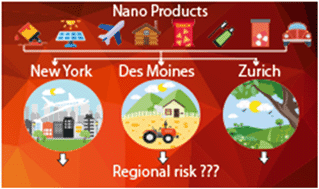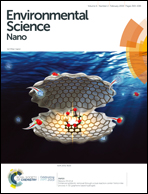Variation in regional risk of engineered nanoparticles: nanoTiO2 as a case study†
Abstract
Predicting environmental concentrations of engineered nanomaterials (ENMs) is key for assessing their risk. We hypothesize the environmental concentrations are a strong function of the environmental characteristics and waste management practices of the locations where the ENMs are used and released. We conducted a case study for nanoTiO2 in six watersheds (Los Angeles, New York, Des Moines, Rome, London, and Zurich). For a near-field analysis, we investigated the 500 m freshwater reach downstream of a point source in Zurich. The analysis was conducted with nanoFate, a dynamic multimedia fate and transport model which considers daily variability in release, climatic, and hydrological conditions. ENM release fractions to environmental compartments differ regionally by up to 28%, compartment concentrations vary regionally by up to three orders of magnitude, high daily variability of nanoTiO2 observed within air and freshwater, and adverse effects to aquatic organisms such as respiratory inflammation may be present in the freshwater compartment of Los Angeles and downstream of the Zurich point source (peak concentrations of 1490 and 619 μg L−1 respectively). Concerns to aquatic organisms in Los Angeles are episodic, depend on meteorological variations, and would not have been predicted by steady-state or material flow analysis models. This highlights the significance of refining spatio-temporal resolution for a more comprehensive ENM risk assessment.



 Please wait while we load your content...
Please wait while we load your content...
